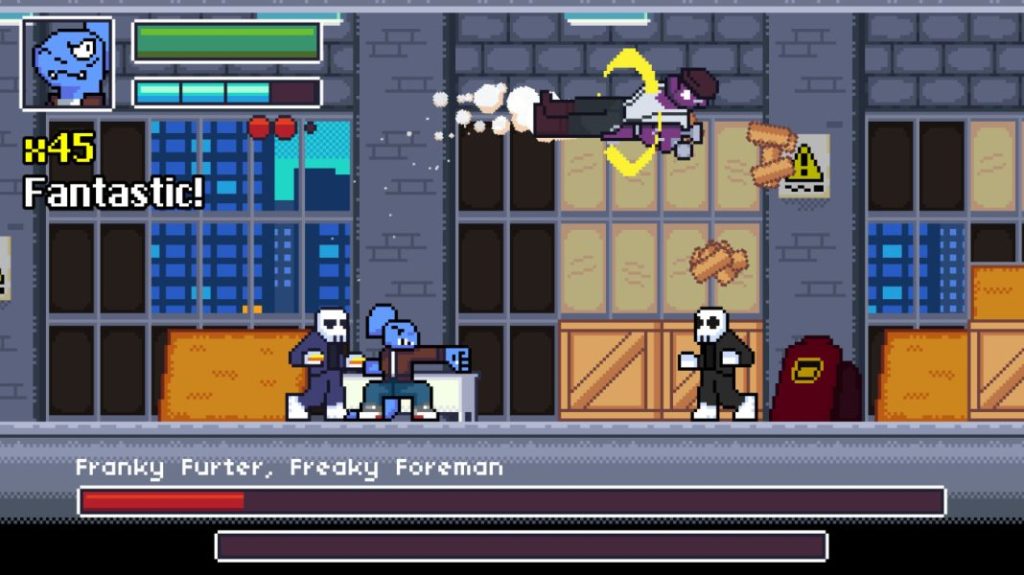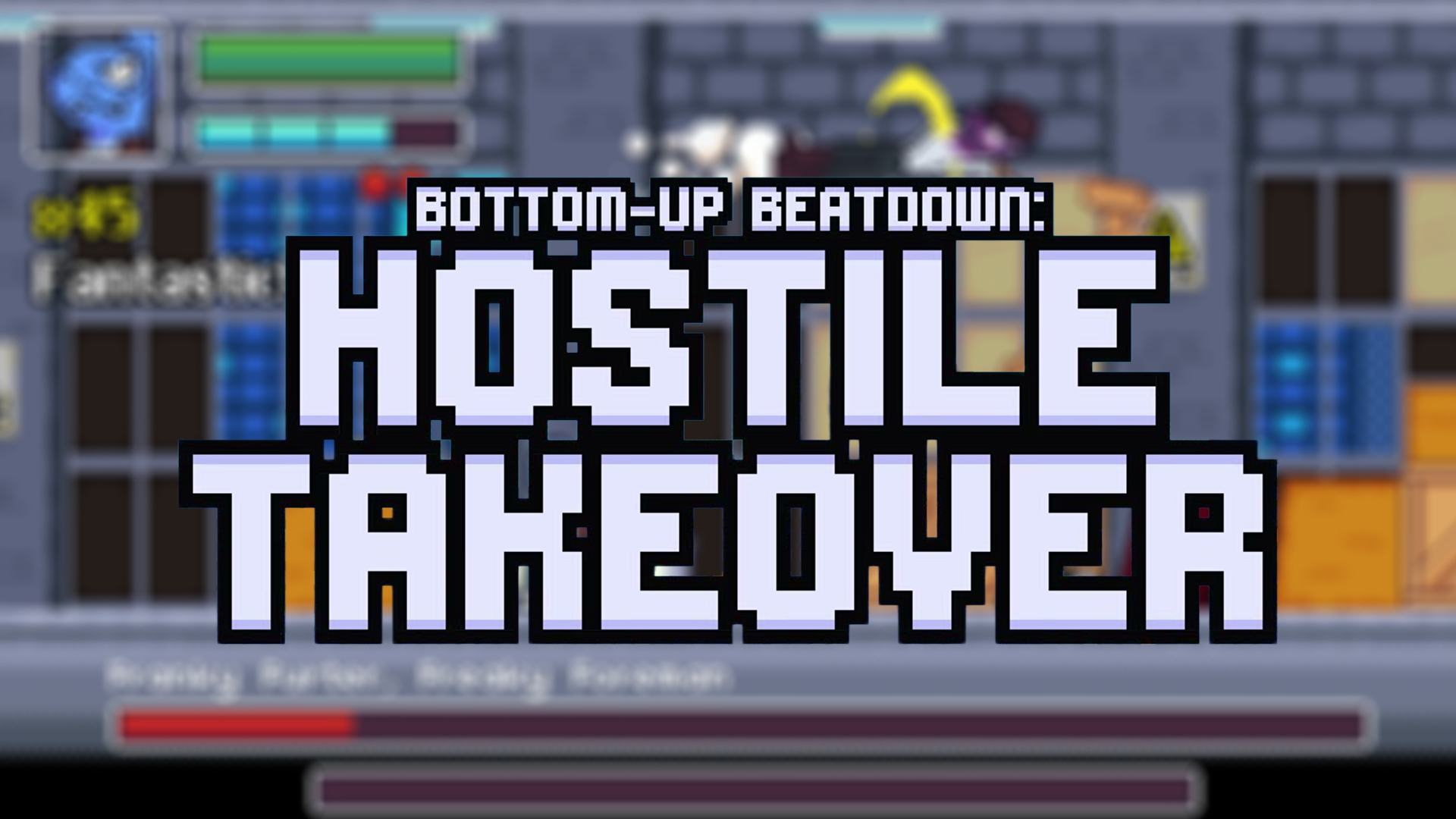Bottom-Up Beatdown: Hostile Takeover feels like it was ripped straight out of a hyperactive Saturday morning lineup and dropped into a modern character action game. It is a fast, combo-heavy beat ’em up set in a world overrun by monsters, built with the crunchy impact of arcade brawlers and the expressive flair of Nintendo DS era sprites. Behind it all is a solo developer who took post-college boredom, a love of No More Heroes and Castlevania, and a deep appreciation for tokusatsu weirdness and turned it into a full-on project.
In this SDC Spotlight, we talk with the creator of Bottom-Up Beatdown about where the game came from, how classic fighting games and action titles shaped its combat, and why making bosses feel like anime rivals is just as important as making them challenging. We also touch on the realities of building a game mostly alone, what early playtesters are asking for, and how the dev is trying to balance personal artistic goals with making something people will actually want to buy.

For readers who haven’t yet tried out the demo, how would you describe Bottom-Up Beatdown: Hostile Takeover in one sentence?
Beat ’em up meets character action in a modern world filled with monsters!
Where did the core inspiration for Hostile Takeover come from?
To be honest, I was half a year out of college and I was extremely bored. I figured I was only getting older, so making a dream project before I found a full-time job or the world ended would be nice. After playing No More Heroes, the idea stirred in my head for a couple of years, so that’s probably where the core inspiration comes from.
When I was playing the demo, I was reminded of early Nickelodeon shows and Game Boy Advance games from my youth. Were there particular games, comics, or films that influenced the tone, art style, or combat feel of this project?
Actually, before I started on the game I got really into Castlevania, so there’s a lot of influence there. Specifically, after playing Portrait of Ruin and seeing how amazing that looked, I wanted to design the game as if I were creating it for the Nintendo DS.
Art style and tone wise, the game is heavily inspired by Astro Fighter Sunred, a parody show about a washed-up sentai hero. That show was life-changing and really got me into traditional tokusatsu like Kamen Rider and the Godzilla series. While many of the monsters in the game are inspired by classic Hollywood movies, I wanted to take that and put a silly spin on it similar to what games like Darkstalkers did.
Gameplay-wise, it’s really hard to pick just one influence, as I blended a lot of ideas from different games into this one. Devil May Cry and God Hand stand out as big influences, but mechanics like the juggling system are more Tekken or King of Fighters.
How did you settle on that aesthetic, and were there any visual styles you experimented with but decided against?
The DS aesthetic was the perfect resolution for the game I wanted to make, as it offered just enough sprite detail to make really expressive sprites, but not so much that I’d be spending a year animating one character. The original Bottom-Up Beatdown had a much higher resolution, and while I’m definitely proud of the work I did back then, I think the art quality was a little scuffed, and animating took way too long. Also, I would’ve loved to go 3D, but my protagonist, Biff, kinda looks funky in 3D. I’ll try again one day.
How long has the game been in development, and how has your vision for it evolved?
The game’s been in development for a little under a year now, but the original idea came to me years ago while I was still in school. I ended up making the very first Bottom-Up Beatdown three years ago, and that game was just a boss rush with more traditional beat ’em up elements. I found that the way I designed bosses for that game really didn’t need that third dimension, so I cut it out for this game.
Is this a solo project or a small-team effort?
Solo project, but I’ve had a ton of support from friends. I’ve also hired some composers for the music. Maybe in the future I’ll have a team of voice actors as well.
What have been some of the biggest lessons you’ve learned during development?
The game is always twice as difficult as you think it is. I’m always playtesting bosses and I’m extremely familiar with their movesets (especially after animating all their moves), so it’s pretty easy for me to perfect bosses. Because of this, I’ll end up raising their health or increasing their speed, but then watch as players lose to Franky, or even just the bat goons, way too many times. Playtesting early and often is definitely the biggest lesson I’ve learned so far. Also, gamers will make it their mission to never read any tutorial prompts, even if you put pictures.
Blending classic 2D beat ’em up style with “character action” mechanics like wall-bouncing and juggling sounds tricky. What was the biggest design challenge in making that work?
I think the key to adding these character action mechanics in a beat ’em up is to put less focus on the combo game and more on what makes these options meaningful outside of combos. Abilities like wall bouncing reward players for cornering enemies with a longer stun, and juggling removes the potential for counterattack from enemies like the bat or sword goon. That way, while these features help with creating stylish combos, their purpose isn’t just combo filler but enemy management.
Combo-heavy gameplay can be tough to balance. How did you fine-tune the difficulty so both casual players and score chasers could have fun?
Doing sweet combos is nice, but I made sure that even button mashers have a lot of fun. The combo game is there for players who have mastered the system, but casual players can pull off moves like the reversal pretty easily. I’m hoping there’s a low barrier to entry and a high skill ceiling.
For players looking forward to the full game, what are two or three mechanics you’re most excited for them to discover?
Though it’s not in the demo yet, there’s going to be a sweet grappling system that’s an iconic part of any beat ’em up and will help with those crowds of enemies. Also, I hope players can enjoy the progression system, where you’ll be able to chill at your friend’s house between missions and train with Sue Flay to unlock new abilities.
Bosses like Franky Furter are pretty memorable. How do you design boss fights that reflect personality and theme?
I’ve played a lot of fighting games and watched a ton of anime, so making characters with strong personalities is really enjoyable for me. I like to think about their fighting style, special moves, and especially how they’d taunt you mid-battle. Mainly, I’m just thinking about how it would look if it was a shonen anime.
For you personally, is there a particular level, mechanic, or moment from development that stands out as your favorite?
I love the Sue Flay boss fight, because I love rival battles in action games with characters like Vergil or Henry Cooldown. Since it’s the first one, her moveset’s a little limited, but I can’t wait to work on her fights later in the game.
What’s the most broken combo or bug you discovered during playtesting that secretly made you laugh before fixing it?
If you press dash and jump on the same frame as Biff, you do a crazy fast super jump. It’s pretty fun, and to be honest, I haven’t even patched it out.
What kind of early player feedback from the demo or playtests has surprised you the most?
A lot of people have told me they want a versus mode, which isn’t that surprising, but the number of folks who have requested it was a lot higher than I anticipated. It’s on the way.

Looking ahead, what does the roadmap for Bottom-Up Beatdown look like? Are you planning more levels, characters, or post-launch updates?
The full game will have at least nine full levels, with bonus levels and co-op available for all of them. It will also include multiple game modes like Overtime Mode, Boss Rush, and Versus Mode. By the end, it would be great if all the bosses were playable in some form as well, even if with limited movesets. Finally, after launch I would love to continue working on the game, especially by adding a full campaign for Sue Flay in the future.
If you could have any other video game character join as a guest fighter in Bottom-Up Beatdown, who would it be and why?
I’ve thought about this a lot even before this interview because I love crossover characters in games. While I’d love to put one of my idols in like Travis Touchdown or Dante, I think they’d look a little out of place. If I had to seriously choose just one, I’d put in Nemesis from Resident Evil 3, because I love playing him in Ultimate Marvel vs. Capcom 3 and he’s just such a cool monster.
We’ve got one more question for you, coming from the devs of our previous SDC Spotlight, A La Card: How do you balance the art you want to make with the product you want to sell? And finally, what question would you like to ask the next SDC Highlight developer?
This question is tough because this is the first game I’m planning on selling for real money. I definitely have had to sacrifice some ideas in order to make completing this game viable, but I’m honestly just happy to finally put these thoughts in my head out in the open as something legible. However, I absolutely want to make the game a lot more difficult, so balancing that with being an accessible game for all ages is extremely tough.
For the next developer, I’d like to ask how their level design process goes.
As Bottom-Up Beatdown: Hostile Takeover heads toward a full release, it already feels like the kind of passion project that could turn into a cult favorite. There is a clear love for fighting games, anime rivals, and old handhelds baked into every choice, from the DS-style sprites to the “broken but fun” tech the dev secretly hopes players will find.
If you want to keep up with development, share feedback, or eventually lab your own wild combo routes, you can follow along on X, hop into the Discord, and watch for future devlogs. And in true SDC Spotlight fashion, we will pass the torch with the dev’s question for the next highlighted creator: how does their level design process work, and what does it reveal about the kind of game they want to make?

